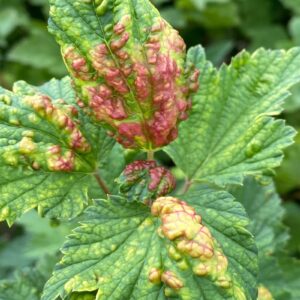

What most people don’t realize is that these pesky little insects come in many different sizes and colours. Most commonly in Alberta, you’ll see green, yellow, black, or brown aphids. Described as “juicy-looking” bugs, these soft-shelled insects are literally just that – slow, plump, and sweet to eat (for their predators, that is).
Ok so there aren’t a lot of reasons to love aphids. In fact, besides humans, aphids have a lot of enemies! Because they’re easy to catch and full of sugars, there is a whole host of bugs that hunt aphids including lady bugs, hoverflies, lacewings and birds. Aphids play an important role in the greater ecosystem by providing a source of food to predatory insects and some pollinators, as well as keeping plant life in check by snacking on it – out there in the wild, that is.
Aphids also poop sugar (yep), so they also attract symbiotic bugs, like ants, to follow them around and feed on their waste. If you’ve noticed ants all over your plants, take a second look for aphids (read more about ants here).
Naturally, you don’t want aphids snacking on your plants, because YOUR plants don’t need to be kept in check. Aphids can quickly become a problem as they reproduce and make one (or more) of your plants their feeding ground. Aphids have a short, quick, life cycle, and though they start as crawlers, they eventually develop wings and transfer to new plants by way of flying. It’s pretty much impossible to avoid aphids in your outdoor gardens, and you’re guaranteed to see some on your herbs (wash thoroughly!), vegetables, and trees. But the good news is that with lots of plants to munch on and unlimited room to spread out, most gardens don’t end up with problematic infestations.
Houseplants, on the other hand, are pretty susceptible to aphid damage. Aphids give ‘live birth’ to their young (no eggs), and because their life cycle is short, they reproduce dramatically fast. With limited plants to spread out to, an aphid infestation can quickly stress or damage a houseplant, and even spread to other plants in the vicinity once the aphids can fly.
Outside, you’ll see aphids from early spring, all the way through to late fall. When temperatures warm up, the aphids are out! Inside, you could find aphids at almost any time of year. Newborn aphids are microscopic, and definitely not obvious to the naked eye. They are abundant in nature, and it’s easy for them to survive in greenhouses, nurseries, shipping containers or homes. It’s common for aphids to find their way into a new environment by hitching a ride on a new houseplant, or even a piece of clothing. For this reason, many seasoned houseplant-ers will ‘quarantine’ new plants for a period of time – long enough to detect any existing pests – before introducing those plants to the rest of their collection.
Aphids are famous for hiding on the underside of leaves, along the stock of the plant, or in the natural adjoining crevices of a branch and stem. Don’t forget to check your plant carefully!
Aphids are ‘sap-suckers,’ meaning they feed on the sap and juices of the plants they frequent. This can cause everything from yellowing, to full-on deformities, and other additional signs of plant stress. If the population of aphids is large enough by comparison to the plant to consume a large percentage of the sap, a plant may lose leaves, branches, or valuable strength for the winter season. Typically, large trees are too big to be severely damaged by an aphid population. But garden beds, houseplants, and other smaller specimens are not.

Often, you’ll notice the aphids first – those tiny, plump, round bugs crawling around the leaves or stalks of your plant. You’ll likely see several generations at once, with some being larger and others smaller. In particular bad cases, a stem or leaf might be ‘crawling with aphids.’
Sometimes, if a population of aphids is particularly adept at hiding on your plant, you’ll notice deformities first. “Gall” describes the deformation of leaves that can happen when important nutrients are being sucked out of the plant as it produces new growth. If you notice deformities appearing, flip the leaves over and scan the stems of your plant carefully. You’re likely to find the perpetrators hiding somewhere out of plain sight!
You may also notice tiny white ‘molts’ that almost look like
skin flakes (gross, right?), which are the shells that aphids leave behind at various stages in their life cycle.
Water: A surprisingly effective way to deal with aphids, spraying your plant down with water will knock a great deal of them off of your plant. You can even use your hands to gently rub the leaves off while you’re washing.
End All: This miticide/insecticide is actually OMRI listed, and approved for organic gardening. It kills aphids on contact and breaks down quickly when exposed to air and sunlight, so it can even be used up to one day before harvesting an edibles (we recommend a good washing, still). A good blast of end all should deal with your aphids, but it never hurts to use the ‘water’ method to deal with stragglers. If your aphid population persists, you can re-apply in the next 10-14 days.
Persistence: This. Is. Key. Because new aphids are super tiny (often unapparent), quick-growing and quick to reproduce, a few survivors can quickly re-populate. In the weeks following your initial treatment, keep an eye out for new signs of aphids and use water or end-all to quickly eliminate new offenders!
Check out our full bug series here, and follow us on Facebook to get notified as we release new articles in the series!

We are Cochrane & West Calgary’s largest Garden Center, owned-and-operated by plant-loving locals. We’re glad you’re here. You can visit us 7 days a week in store, or online. Get Directions
Get free gardening resources, monthly coupons, and new arrival alerts, straight to your inbox.
Join Now